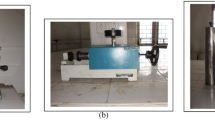Abstract
Ferrous metals can be cast economically in cement-bonded sand moulds with a good dimensional accuracy. In the present work, forward and reverse mappings were carried out in cement-bonded sand moulding system by utilizing three different fuzzy logic (FL)-based approaches. The mould properties, namely compression strength and mould hardness were predicted in forward mapping for a set of input parameters. The amount of cement, accelerator, water and testing time were considered as the input parameters. The reverse mapping is a convenient and effective tool to control the process, as it can be used to determine a set of input process parameters that will produce the desired output (also known as responses). Manually constructed Mamdani-based FL system is used in the first approach. The rule base and data base of the FL system constructed in approach 1 has been optimized in the second approach. Finally, GA was used in the third approach, for the automatic evolution of the FL system. The performances of the developed approaches were tested with the help of twenty test cases and found to be satisfactory for the cement-bonded sand mould system.
Similar content being viewed by others
References
Neville AM (1996) Properties of concrete, 4th edn. Longman, Harlow Essex
Sleicher CA, Providence RI (1943) Use of cement in foundry molding. AFS Transactions 51:737–747
Schleede EH, Chicagi I (1944) The use of gypsum cements in pattern and model making, Pattern Making Session of the 48th Annual Meeting, American Foundrymen's Association, Buffalo, N.Y., pp 1271–1285
Uchikawa H, Uchida S (1976) On the special super-high early-strength cement sand process (OJ Process). AFS International Cast Metals Journal 1:31–37
Chakraborty M, Dhindaw BK (1977) Application of statistical design of experiments in the study of self-hardening sodium silicate bonded sand mixtures. The British Foundryman 70:146–152
Parappagoudar MB, Pratihar DK, Datta GL (2007) Linear and non-linear statistical modeling of green sand mould systems. International Journal of Cast Metals Research 20(1):1–13
Parappagoudar MB, Pratihar DK, Datta GL (2007) Non-linear modeling using central composite design to predict green sand mould properties. Proc IME B J Eng Manufact 221(5):881–895
Parappagoudar MB, Pratihar DK, Datta GL (2008) Linear and non-linear modeling of cement-bonded moulding sand system using conventional statistical regression analysis. J Mater Eng Perform 14(4):472–481
Starobin A, Hirt CW, Goettsch D (2009) A model for binder gas generation and transport in sand cores and molds. Modeling of Casting, Welding and Solidification Process XII. J Miner Met Mater Soc. http://www.flow3d.com/pdfs/tp/cast_tp/FloSci-Bib19-09.pdf. Accessed June 2009
Hong IT, Tung HC, Chiu CH, Huang HS (2009) Effect of casting parameters on microstructure and casting quality of Si-Al alloy for vacuum sputtering. China Steel Tec Report 22:33–40
Reilly C, Jolly MT, Green NR, Gebelin JC (2010) Assessment of casting filling by modeling surface entrainment events using CFD. In: TMS Annual Meeting & Exhibition (Jim Evans Honorary Symposium), Seattle, Washington, USA, February 14–18, 2010
Yan GH, Zhao SD, Sha ZH (2010) Parameters optimization of semisolid die casting process for air-conditioner triple valve in HPb59-1 alloy. Adv Mater Res 129–131:936–941
Pratihar DK (2008) Soft computing. Narosa Publishing Home, New Delhi, India
Babu NN, Ohdar RK, Pushp PT (2006) Evaluation of green compression strength of clay bonded moulding sand mix: neural network and neuron-fuzzy based approaches. International Journal of Cast Metal Research 19(2):110–115
Benny Karunakar D, Datta GL (2007) Controlling green sand mould properties using artificial neural networks and genetic algorithms—a comparison. Appl Clay Sci 37:58–66
Parappagoudar MB, Pratihar DK, Datta GL (2008) Forward and reverse mappings in green sand moulding. Appl Soft Comput 8(1):239–260
Parappagoudar MB, Pratihar DK, Datta GL (2007) Modelling of input–output relationships in cement bonded moulding sand system using neural networks. International Journal of Cast Metal Research 20(5):265–274
Terashima K, Nomura H, Yamakita N, Sasagawa E (1992) Optimum design of particulate mulling process by hybrid system of fuzzy control and adaptive predictive control. Transactions of the Society of Instrument and Control Engineers 28(6):707–716
Surekha B, Vundavilli PR, Bhat RP, Parappagoudar MB (2009) Design of fuzzy logic-based expert system for forward modeling of green sand mould system. IJMAE 4(No. 5):69–93
Surekha B, Vundavilli PR, Parappagouadar MB, Srinath A (2011) Design of genetic fuzzy system for forward and reverse mapping of green sand mould system. International Journal of Cast Metal Research 24(No. 1):53–64
Mamdani EH, Assilian S (1975) An experiment in linguistic synthesis with a fuzzy logic controller. Int J Man Mach Stud 7:1–13
Author information
Authors and Affiliations
Corresponding author
Appendices
Appendix A
Appendix B
Rights and permissions
About this article
Cite this article
Surekha, B., Vundavilli, P.R. & Parappagoudar, M.B. Forward and reverse mappings of the cement-bonded sand mould system using fuzzy logic. Int J Adv Manuf Technol 61, 843–854 (2012). https://doi.org/10.1007/s00170-011-3754-z
Received:
Accepted:
Published:
Issue Date:
DOI: https://doi.org/10.1007/s00170-011-3754-z




